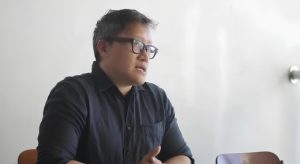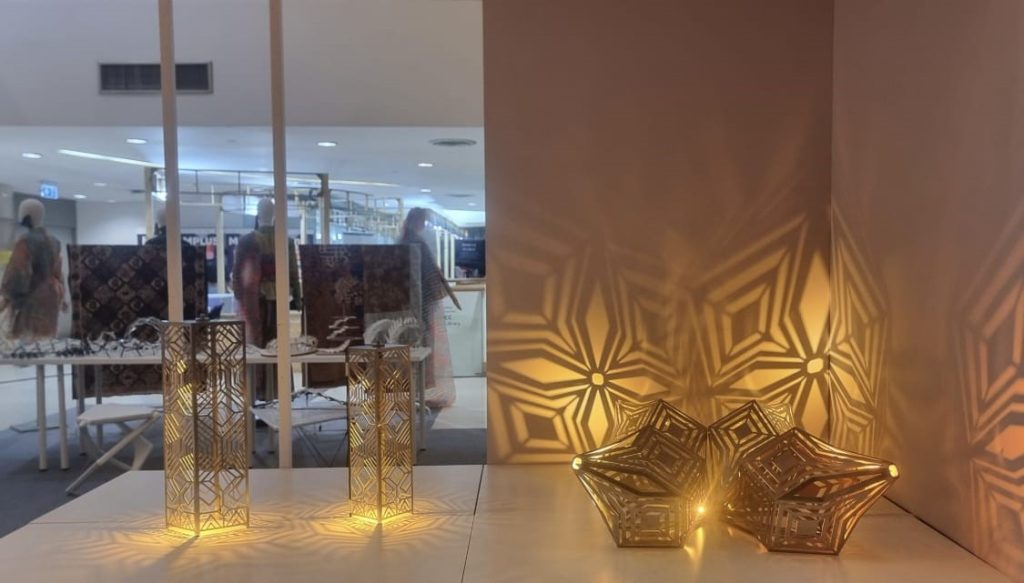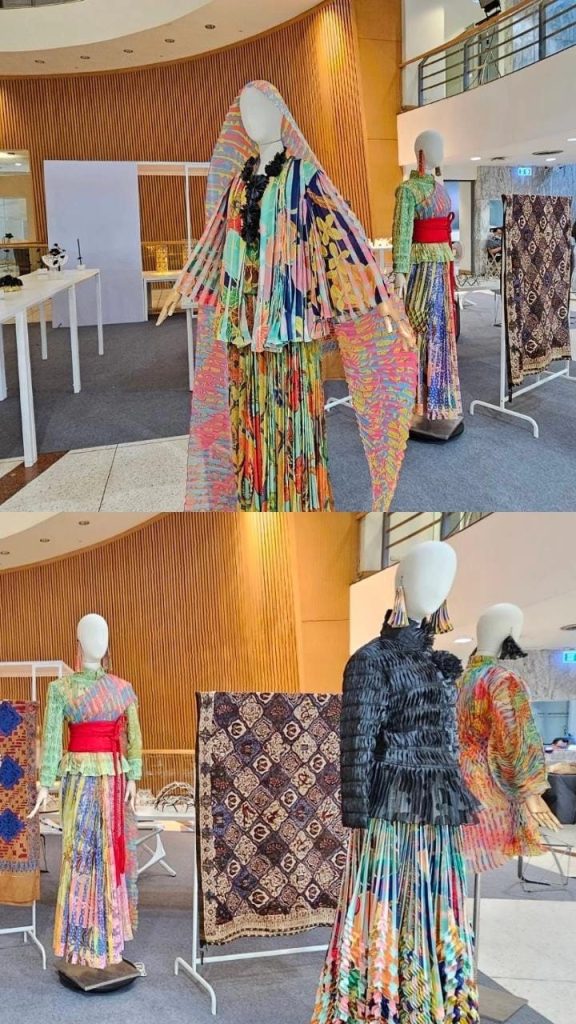

As a designer, creating, conceptualizing, and visualizing works across various fields such as product design, graphic design, or interior design is an integral part of their role. They also strive to blend traditional and modern elements to create innovative works. Alongside Pak Erwin and Pak Sandy, they will share their experiences at the BACC Exhibition (Bangkok Art Creative Center) in Bangkok, Thailand, where they showcased works that are sure to inspire us all.
First, there is Pak Erwin, an interior design lecturer who participated in the BACC Exhibition in early June 2024 as part of his PhD project. Pak Erwin focused on the theme of showcasing the cultural patterns of Sumba fabrics, specifically East Sumba textiles, by transforming them into light and shadow using lamps as his medium. He aimed to research and delve into the patterns of East Sumba textiles, modernize them, and apply them to contemporary lamp products. The inspiration behind his work was to present Indonesian culture to the world, as Indonesian culture is incredibly diverse. One of Pak Erwin’s challenges was maintaining the meaning of the Sumba patterns while creating contemporary lamp designs.


“My inspiration is essentially to highlight Indonesian culture because Indonesian culture is so diverse, unique, and deserves to be recognized globally. I chose the Sumba pattern because there are no other products besides woven fabrics that use this pattern. I wanted to elevate Sumba textiles and apply them to other contemporary products besides wood. The major challenge in creating this contemporary lamp is how to preserve the meaning of the Sumba pattern, which is highly philosophical, so that it does not get lost. Another challenge is that I cannot simply replicate it; I need to be very careful and develop new methods or tools while staying inspired by the Sumba patterns,” said Erwin Ardianto Halim, S.Sn., M.F.A., Ph.D., HDII.
Pak Erwin mentioned that the Sumba pattern is fascinating due to its philosophy related to nature, its uniqueness, and the intricate process of creating the fabric.
“The Sumba pattern is very interesting, firstly because of its philosophy related to nature and the beliefs of the East Sumba community. Not only that, but its uniqueness, shapes, and the process of making the fabric, which is not completed in one or two days but involves a long process, are also significant. The meaning and uniqueness are essential to the East Sumba community,” said Erwin Ardianto Halim, S.Sn., M.F.A., Ph.D., HDII.
Next is Pak Sandy, a lecturer in Visual Communication Design, who was invited to the BACC Exhibition in early June 2024. His showcased work was the design of Batik Tiga Negeri, a concept that is very prominent in Indonesian batik history due to its production across three different locations.
“In the BACC Exhibition, the work I presented is the design of Batik Tiga Negeri. This concept is quite phenomenal in the world of Indonesian batik because it involves producing batik in three different locations. This was done before the use of synthetic dyes; at that time, only natural dyes were used. By the end of the 19th century, synthetic dyes only appeared in 1910, so all batik produced before 1940 used natural dyes. The history of Batik Tiga Negeri involves batik entrepreneurs in the coastal areas of Java,” said Sandy Rismantojo, S.Sn., M.Sc.

Pak Sandy described the unique process of making Batik Tiga Negeri, which reflects the characteristics of the fabric by showcasing three styles from different regions, starting with three different places in Java and later expanding to three countries.
“To make this batik fabric, you need to move between locations. For example, the red color is applied first, followed by blue in Semarang or Kudus, and then moved to Yogyakarta for the slogan dyeing. The entire production can span up to 300 km because it is made in three different regions to create one fabric, making Batik Tiga Negeri a premium product. The uniqueness lies in its visual characteristics, with three styles from each region. This concept, which began in Java, was later developed to include three countries—Indonesia, Malaysia, and Thailand. This development was based on the spread of batik from Java to Malaysia and then to Thailand. Each region has developed its own batik style, with Malaysia focusing on floral motifs due to strong Islamic influences and Thailand developing its own style,” said Sandy Rismantojo, S.Sn., M.Sc.
Pak Sandy also explained the technique used in his work, where batik is aligned with modern changes through digitalization.
“Here, I aimed to find a way for batik to keep pace with modern times. After traditional production, it is digitized and scanned, allowing for greater production without losing its value. The idea is to merge traditional and digital techniques so that batik remains a unique art form while being produced in larger quantities. For my project, I used a technique involving folding, so the fabric can have two different designs that are visible as it moves. This is similar to the Batik Tiga Negeri concept, where one fabric has three visuals,” said Sandy Rismantojo, S.Sn., M.Sc.
In today’s modern era, designers are increasingly using advanced technology, including digitalization. Both Pak Erwin and Pak Sandy utilize digital techniques in their work. They believe that current technology is crucial and that embracing it is important for creating innovative and relevant works. Especially for students in design fields, understanding and utilizing modern technology is essential for producing memorable work. However, they also stress the importance of maintaining one’s unique style and manual methods.
“Technology is extremely important, especially in today’s modern world. For my work, I was inspired by traditional Sumba patterns and used a technique called ethnomathematics to find basic shapes. I also used blooming flower technology so that the lamp can open and close, with laser cutting technology being crucial. This adds value to the product by combining traditional, technological, and contemporary elements. Students should be aware of and embrace technology, not as a shortcut but as a complement to their existing work. I believe that combining strong concepts and designs with technology will result in more appreciated works in the creative industry,” said Erwin Ardianto Halim, S.Sn., M.F.A., Ph.D., HDII.
“Today, technology is definitely necessary for students. However, manual techniques are still needed as a foundation. With AI technology, the goal is to assist rather than replace the designer. Students must use AI wisely while maintaining their unique style. Embracing technological advancements will enrich our designs, but manual methods are crucial for developing one’s design identity. Don’t fear technology; instead, let it enhance your work,” said Sandy Rismantojo, S.Sn., M.Sc.
Pak Erwin and Pak Sandy hope that their works displayed at the BACC Exhibition will inspire future designers to incorporate Indonesian traditions into contemporary products, preserving traditional elements without copying them. Indonesia’s rich cultural heritage offers ample material for creative reinterpretation, and maintaining a unique identity in design is crucial. Embracing and celebrating Indonesian traditions can help create designs that stand out and gain recognition worldwide.
Article by: Anthonia Sylvia
- January 2025
- December 2024
- November 2024
- October 2024
- September 2024
- August 2024
- June 2024
- May 2024
- March 2024
- December 2023
- September 2023
- August 2023
- July 2023
- June 2023
- May 2023
- March 2023
- February 2023
- January 2023
- December 2022
- November 2022
- October 2022
- September 2022
- August 2022
- July 2022
- June 2022
- May 2022
- March 2022
- February 2022
- January 2022
- December 2021
- November 2021
- October 2021
- August 2021
- February 2021
- August 2020
- July 2019
- May 2019
- May 2018
- April 2018
- February 2018
- January 2018
- December 2017
- November 2017
- October 2017
- September 2017
- August 2017
- February 2017






